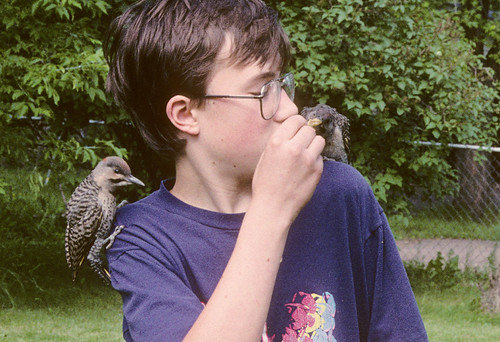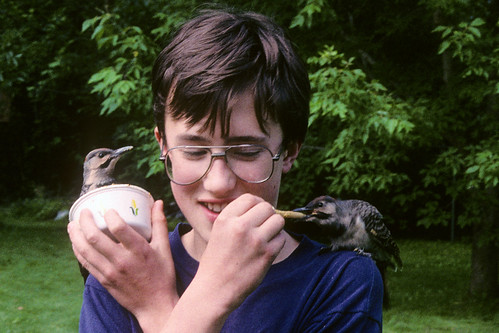Back in the ‘90s when I was a licensed wildlife rehabilitator, one summer I was brought two baby flickers. Their nest tree had broken off right at the nest cavity in a storm. The babies were apparently okay in there, and the parents continued to feed them, but then crows discovered the open nest. They’d carried off at least two nestlings when people climbed up to save the survivors.
The two nestlings were pretty well feathered already, but one of the surprising things I learned about woodpeckers because of this experience is that nestlings don’t flutter or hop anywhere, except, as they get a little bigger and stronger, they work their way up to the entrance hole. They stay securely inside the cavity until they’re capable of powered flight. So even as they grew and became almost full-sized, they stayed put wherever I put them. At night I kept them in an open ice cream bucket, and in the morning brought them into the dining room. I put towels on the backs of two chairs, and newspapers on the seats. The babies clung to the towels for the day as if stuck with Velcro.
Yet even while they are still in their nest cavities, baby woodpeckers start toddling up to the entrance hole, where they get sun exposure, important for their bodies to manufacture Vitamin D. To make up for being stuck indoors, I took a daily walk with them clinging to the pockets of my cargo shorts.
I fed them a powdered commercial baby bird food mix with an eyedropper. Baby woodpeckers grasp their parent’s bill and the parent regurgitates semi-digested insects down their throats, which was pretty easy to mimic with the eyedropper. Keeping them on two separate chairs, we didn’t notice how aggressive baby flickers can be with their siblings.
Baby birds have a wider mouth than adults, often with colorful mouth linings and gape, where the upper and lower mandibles meet. These baby flickers had harder tissue projecting outward a bit there—a firm, pearly projection. I’d never had any baby woodpecker before, so didn’t know this was a feature common to the whole family.
The flickers may have been easy to keep indoors while they were nestlings, but I knew that as soon as they could fly at all, they would be in danger in our house, where not one room was big enough to allow them more than one or two wingbeats without them crashing into a wall. Luckily, I figured this out in time, and started keeping them in a Wood Duck house in a dead apple tree in our yard before they even tried flying. From the start, my sons and I had always whistled before we fed them, and kept this up consistently, so when they could fly, they’d come right to us if we whistled when they were hungry.
That’s when we discovered that, if they both came in at once, they’d attack each other viciously, often aiming for each other’s eyes. Some people believe the whitish projections on baby woodpecker mouths help the parents aim for their mouths in the dark nest cavity, which makes sense, but watching these flickers jousting, I noticed that those mouth projections deflected an attacking sibling’s bill away from the eyes, so these little projections probably serve a bit of a protective function, too.
From the start, we could tell the two apart by their breast markings. One had nice bold spots, leading of course to our calling that one Spot. The other’s spots were far smaller and more delicate, as if painted on with a much finer brush. That one we called Speckles.
After a few days in the backyard, Spot and Speckles started exploring the neighborhood. I took them to a few anthills, but otherwise, they had to pick up all the skills of being wild on the street, so it took them longer to be independent than it would have if they’d grown up with their parents. One of my sons or I would go out in the backyard every half hour or so every day from late July well into October and whistle and Bam! (they flew fast, and landed hard)—one of the flickers would fly in and land on us, and then the other would.
If we got a good meal into the first before the second arrived, everything was easy. But if the second came just moments after the first, we spent an inordinate amount of time trying to keep them from murdering each other. It seemed odd how absolutely opposed they both were to sharing food, because they always flew in from the same direction and every time we spotted them in the neighborhood, they were together.
By October, they weren’t flying in as quickly when we whistled, sometimes disappearing for hours at a time, and weren’t eating as much when they did come in. That’s how we knew they were getting successful at finding their own food. The big surge of flicker migration had ebbed in September, but there were still some others in the neighborhood when Spot and Speckles stopped coming altogether. We never knew if they had started associating with other flickers, but figured they must have worked out migration somehow.
Usually that’s the end of a rehab story—the bird dies or disappears, never to be seen again. But the next spring, one fine morning when Joey was doing his paper route, he heard a flicker and looked up to see it studying him, so he whistled. And Bam!—it flew right to him. He of course didn’t have any food on him, and even a perfectly natural flicker would not be expecting its parents to feed it at this point, but what a thrill to know that at least one of our babies had definitely survived the winter, and definitely remembered us. Those baby flickers were the Best Birds EVER!







